
Living
Games That People Play
Those beeping video invaders are dazzling, fun—and even addictive
Let us have no more lamentation that our microprocessed era lacks heroes (plinkety-plunk of Pete Seeger’s banjo). The spirit of mighty John Henry, the steel-driving man who beat the steam drill (plunk-plunk-plunk), lives on in the indomitable courage and abused optic nerves of a Mount Prospect, Ill., high school boy named Steve Juraszek (Seeger whacks out several yards of fancy banjo work and begins a ballad):
Well, Steve Juraszek dropped in his
quarter,
Just half an hour before
noon (plink-plunk).
He would die in the end, when the
blasters zapped his men,
But he vowed that wouldn’t
happen soon, poor boy.
He vowed that wouldn’t
happen soon.
At six that night they called
his mother,
Said. “Ma’am, your boy’s not
comin’ home.
Hes shootin’ fast and hot, at
the mutants and the pods,
And the microchip is
processing a groan, oh my,
The microchip is letting out a
groan.”
Oh, they fed him on pizza and
cola,
His fingers were cramping up
and cold.
His eyeballs were raw, when a
dum-dee-dum he saw,
And it something, dum-dee-
dum foretold.*
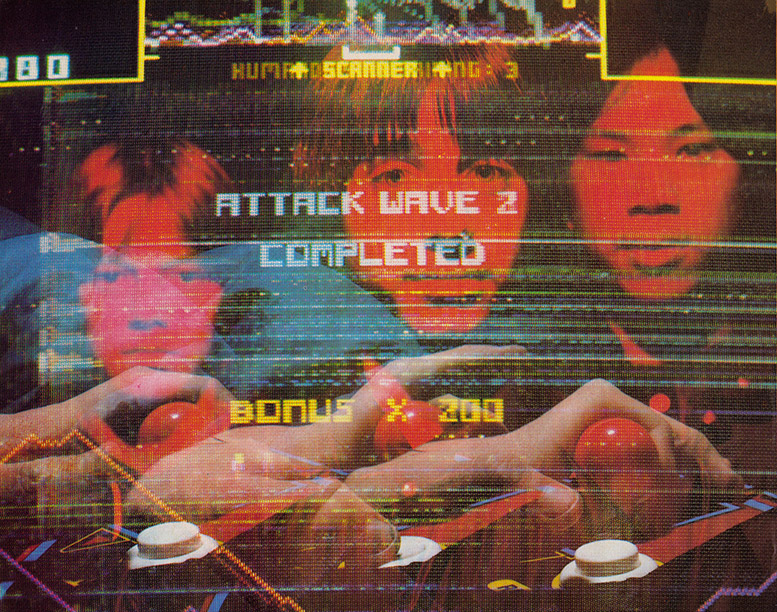
What nonsense is this? The answer is very nearly. but perhaps not quite. in the increasingly crowded category labeled If You Have to Ask, You Will Never Understand. What Juraszek, 15, recently did at an Arlington Heights, Ill., arcade called One Step Beyond was play Defender, one of those beeping, flashing, quarter-eating arcade video games, for 16 hours and 34 minutes on the same 25¢, ringing up a score of 15,963,100 before he finally made a mistake and lost his last ship. Anyone who knows arcade games, and especially Defender, which is one of the most difficult, will agree that this is very close to being impossible. It is definitely not one of those non-feats thought up by the untalented to memorialize themselves in The Guinness Book of World Records, such as eating seven miles of spaghetti, or riding an exercise bicycle for a week and a half.
Defender is an attack-from-outer-space game. It is played on a large color video screen where nullity bombs and destructo beams are hurled at the player by the machine’s computer. Increasingly rowdy sound effects suggest what James Joyce, under the influence of William Blake (who would have loved these gadgets), called “the ruin of all space, shattered glass and toppling masonry, and time one livid final flame.” The Defender player controls a small cannon-firing jet plane that flies at varying altitudes and speeds over a barren planetscape. He must shoot down a bewildering variety of alien bad guys, each with his own pattern of behavior: dodge an assortment of missiles: and rescue helpless spacemen, vulnerable to being kidnaped, who appear randomly on the planet’s surface. He must have reflexive control of a joystick that determines altitude and of five separate buttons that fire the cannon, change forward thrust, reverse direction, make the ship skim off the screen into hyperspace and fire a limited supply of smart bombs, which blow up everything in sight. As is fiendishly true of all of the good new video games, as the game progresses, Defender shifts to subtler strategies and sends out its alien waves with increasing speed. You play the machine and it plays you.
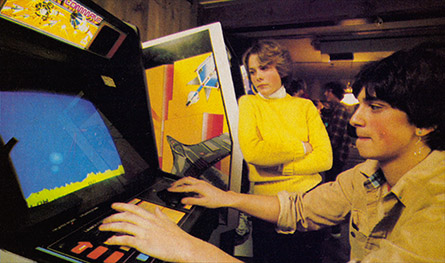
A neophyte has as much chance with Defender as he would if he were to take over the controls of an F-16. A reasonably good video-game athlete—that is how game junkies are beginning to describe themselves—will last it out for a few thousand points, or a couple of minutes. A superb player, the kind not seen in every arcade, may hit 500,000 on his best day. That is why when Juraszek began to close in on 1 million points toward the end of the first hour of his enchanted run, people began to notice. Darrell Schultz, one of the arcade’s owners, asked Steve if he thought he could set a record.
“I said, ’Yeah,’” Juraszek recalls, “and he said, ’Go for it!’” Juraszek is a gangly young man who began playing pinball when he was ten, before video games had hit the scene. “I could buy a car or something with the money I’ve put into games,” he says. with no appearance of regret. He started playing Defender in June, and by August he was pretty good. On his record day he kept up his strength by snapping at pizza slices that people held in front of his face. He said later that he was so excited he never even thought about going to the bathroom. His mother Joanne Juraszek watched for a while, utterly unimpressed, and agreed reluctantly to let him play till he dropped. “I just wish,” she said later, “that he was this good about doing his homework.”
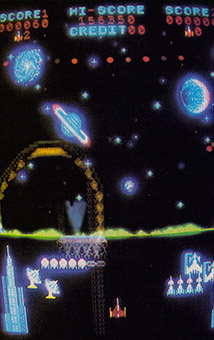
As the scornful cry “So what?” echoes from glen to glen, and as the unmoved Joanne Juraszek admits that she finds her son’s new fame “very strange,” skeptical citizens might do well to pay attention to a peculiar clinking sound audible across the land. The noise is made by the estimated 20 billion quarters that poured last year into the arcade monsters. This is a figure that may be the public relations roar of a healthy young industry beating its chest, but one that investment analysts who specialize in the entertainment industry agree is not far wrong. While they spent this $5 billion, video-game addicts also were spending 75,000 man-years playing the machines.
These figures do not include an estimated $1 billion that consumers paid for video-game consoles that hook up to home television sets, and for the expensive cassettes that make them work. For comparison, $5 billion is exactly twice the reported take in the last fiscal year of all of the casinos in Nevada. It is almost twice the $2.8 billion gross of the U.S. movie industry. And it is three times more than the combined television revenues and gate receipts last year of major league baseball, basketball and football.
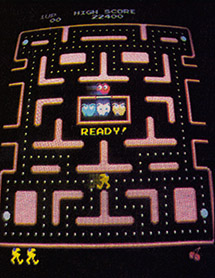
From what vast aquifer of cash does this astonishing gush of money flow? From the lunch money of schoolchildren, say angry parents who are determined, so to speak, to give video games no quarter. The town fathers of Irvington, N.Y. (pop. 6,000), rose up in wrath last July and passed an ordinance designed “to protect the adolescents of the village against the evils associated with gambling” (though video games offer no cash payoff and indeed almost never click out a single free game); they limited each establishment to three machines. Ralph Provenzano, owner of a deli opposite the Irvington Middle School, resents the suggestion that he is corrupting the youth, but agreed to turn off his three machines (Defender, Pac Man and Centipede) before the start of classes each morning. With some justice, he says, “I baby-sat a bunch of kids here all summer. It may have cost them money, but they were here, they were safe, and they didn’t get into trouble.”
The fears that occasionally are voiced of drug-buzzed, beery teen-agers hanging around video parlors in menacing packs seem absurdly exaggerated, and the likelihood is that communities with troublemaking youngsters had them before the arcades opened. But the video games are enormously addictive, and they do eat a lot of quarters. Atari, one of the leading video-game manufacturers, advertises a cheerful, fast-moving and very popular arcade game called Centipede with the words “Chomp. Chomp. Chomp. Chomp. Chomp” above a drawing of a voracious-looking centipede gnawing a coin.
An adult observer in New London, N.H. (pop. 3,000), wanders into Egan’s, a pizza parlor with twelve video games, which has become the town’s teen hang-out since it opened a few months ago. The place is clean and friendly, with no smell of funny cigarettes (many arcades sternly forbid smoking of any kind) and nothing in sight more menacing than an anchovy pizza. But a conversation with a twelve-year-old boy who is holding his own against Scramble, a Stern Electronics game in which the player tries to fly a jet through what looks like Mammoth Cave, produces unsettling information. “I usually bring $20,” says the boy, when asked how much money he spends. As the observer is digesting this, the boy adds, “But today I brought $40.” Proprietor Bob Egan, an insurance broker in New Jersey before he moved to New Hampshire last year, says that he too was surprised, but yes, the boy did change $40.
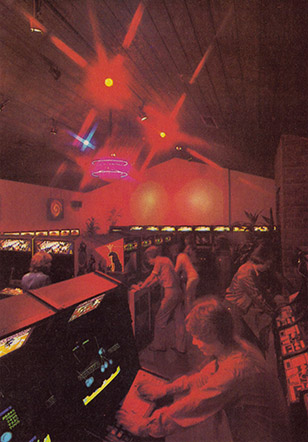
In Orlando, Fla., the consensus of fifth-graders at Blankner Elementary School is that $3 is a “minimum satisfactory amount” to take to an arcade, but several children talked of spending $10 or $20. “I used to spend money on my bike,” one boy said ruefully. Not all game players throw huge sums into the coin chutes, but they agree that it takes an investment of between $20 and $50 to become proficient at any game challenging enough to be fun. There is no question that the money drain is one reason why such communities as Babylon, Long Island, Oakland, Calif., Pembroke Pines, Fla., and Durham, N.H., have passed ordinances restricting play by teen-agers of various ages. The New Hampshire Civil Liberties Union asked that enforcement be postponed till the U.S. Supreme Court rules on an ordinance passed in Mesquite, Texas, forbidding play by people under 17. Lower courts have twice struck down the ordinance.
The fact is, however, that teen-agers hoping to bankrupt themselves blissfully with a session of Asteroids or Missile Command may be frustrated not by a prejudicial ordinance but by a lunchtime crowd of adults monopolizing the machines. The Station Break Family Amusement Center in Washington’s L’Enfant Plaza opens at 7 a.m.; by 7:15 a dozen men in business suits are blasting away at the games while coffee in plastic cups grows cold. L’Enfant Plaza is within walking distance of at least five major Government agencies. “Office workers seem to need to blow it out” in their fantasies more than other people, says Tom McAuliffe, 33, vice president for operations of the 51-store chain that owns the arcade.
By lunchtime, with no teen-agers and not one pair of blue jeans in sight, the 47 machines are making a commotion like Mount St. Helens clearing its throat. Curt Myron, 37, is there, a mortgage supervisor at hud, who is one of the arcade’s top guns. Years ago, pinball cowboys would tape notes to the sides of the machines boasting of their best scores. One of the cleverest come-ons of the video games is circuitry that congratulates hot-shooters with great game! and the opportunity to record on-screen their initials and scores for a display that flashes periodically. It is the solid-state equivalent of “D. Boone Killed a Bar,” and it means that Myron, who earned the four top scores on the arcade’s Centipede machine, is held in awe by the other regulars. He skips lunch, he says, and plays every day, so proficiently that he rarely spends more than 75¢. “I also play in airports,” he says, “much to my wife’s chagrin.”
Eric Mondres, 26, a Department of Agriculture staffer. is less cheerful about his addiction. “It’s like a drug,” he says. “You see the same people here week after week. I’ve tried to wean myself. I’d like to have back all the money I’ve spent.” Near by, wearing a wet raincoat and steamy glasses, a middle-aged man jabs furiously at the thruster of a Star Castle game. He admits to being an attorney in private practice, but says, “I’d really rather you didn’t use my name. This is my secret place. It would drive my wife crazy. I really don’t come here very often.” Two hours later, he is still there battling the machine’s alien psychology—and his own.
An onlooker watching such a scene and disposed to gloom would have no trouble detecting the smell of society’s burning insulation. Contrariwise, an optimist sees these lunchless loners as sensible adults wisely granting themselves a period of therapeutic play, avoiding the intake of cholesterol and booze, and emptying their minds of clutter by a method quite as effective as meditation. In Japan, where many of the games originate, a 29-year-old magazine executive named Shozo Kimura, who admits the games have hooked him, views the mass addiction moodily: “Tokyo is a big town. You think you are not lonely, but it is the opposite. People have nothing to do. They don’t care about anything. They can’t buy houses. They can do nothing with their money except play the games.”
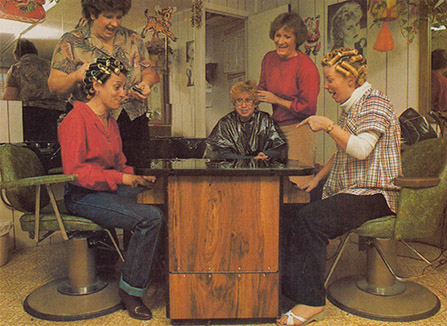
The video-game craze, more frenzied even than the universal lust for designer jeans and Kalashnikov assault rifles, has spread across the globe. In West Germany, merchandisers are toting up astonishing Christmas season sales figures that may reach $88 million for home-video consoles and cartridges. In Australia, the quarter-eaters, actually 20¢-piece eaters, bring in $182 million a year. Fascination with the games, often accompanied by cosmic brooding about their presumed bad effect on faith, morals and school attendance, seems to be universal. The games have appeared in Arab settlements in Israel, and in Soweto, Johannesburg’s huge black township. Brazil’s laws forbid the importing of video games, so they are manufactured locally, and are given the necessary touch of international chic with such English names as Aster Action and Munch Man. In Mexico City, the hot arcade is Chispas (“Sparks”). Video arcades are replacing pool halls as the traditional lounging places for young men in Madrid.
Homosexual cruising is a problem in Amsterdam’s arcades. In Stockholm, the games are associated in the public mind with teen-age hoodlumism involving drugs, prostitution and illegal hard liquor. Video addicts under J 8 are banned from arcades in West Germany, although younger teen-agers manage to play on home sets in department stores.
In the Philippines, outcries against “the ravages of a destructive social enemy, the electrical bandit,” as one infuriated citizens’ group called the video games, reached such a level of indignation that President Ferdinand Marcos banned the machines in November and gave owners two weeks to smash them. The Catholic Women’s League of Caloocan City applauded the ban, asserting darkly that the games had lured young men into beer houses, where they saw burlesque dancers. A wealthy businessman was reduced to public despair because the games had caused the ruin of one of his children, a 17-year-old son whose infatuation with gadgets was so complete, he refused to attend school or even see his friends. The distracted father thinks of sending the boy to school in the U.S., but has doubts about it, because “I fear the video games will catch up with him there.” He says that “when it finally dawned on me what had hit me, my first impulse was to put up a video-machine parlor and let my son manage what he enjoys doing most. But then my wife prevailed on me, begging me not to, saying that if I went ahead with my plan, how many more young boys and girls would be ruined?” In the meantime the arcade owners, who, of course, merely hid their machines, are lobbying President Marcos to relax his ban. Not long ago, 50 disassembled video games, listed as “rectifying apparatus parts,” were seized by Philippines customs agents.
In Hollywood, on the other hand, Producer Frank Marshall thinks the video games are “great if you want to take 15 minutes and block everything out. When you’re shooting a movie, you’re constantly on this high level of adrenaline, and these games use that level to completely absorb you.” He kept an Asteroids machine in his office during preproduction work on Raiders of the Lost Ark. “It got out of hand,” he confesses. “People actually got fired for spending too much time on it.” Nevertheless, there are a Defender, a Missile Command and a Donkey Kong game in the offices he shares with Director Steven Spielberg and Producer Kathleen Kennedy. Not many citizens can afford video-arcade games that cost up to $3,500, but two Manhattan dentists, Phil Pierce and Jeanette Tejada, have a Space Invaders on order for their waiting room. There are also machines at other odd way-stops: a Y.M.C.A. in Grand Haven, Mich.; a Baptist church in Merritt Island, Fla.; the basement of Yale’s freshman dorm. At Fort Eustis, Va., the Army employs a modified Battlezone as a weapons-training device. The Epilepsy Center at Johns Hopkins University Medical School uses three specially wired Atari sets to determine the effects of anticonvulsant drugs on learning and ability. The advantage of the games, according to Dr. Eileen Vining, associate director of the center, is that children are eager to make their best efforts in eye-hand coordination tests. The Capital Children’s Museum in Washington uses video-game techniques, including wildly changing colors and fast interaction between machine and operator, to teach preschoolers about computers. Children learn measurement by playing with a hungry cartoon worm that eats centimeter segments of lines.
Beating the Game Game
Of the hundreds of video games introduced each year, most flop utterly, as if their screens and chips gave out algebra rays or tax-audit emanations. A few do moderately well. And once every year or so a new game jumps into the public’s lap and licks its face, and proves so endearing that money in unbelievable abundance falls on the heads of its fortunate makers. It is very hard to predict which game will be a lap jumper. Robert Mullane, president of Bally, admits that he was not impressed with his first view of Pac Man, the company’s most successful game. “Who plays a maze game?” he remembers thinking.
To assist in divination, game companies bring in packs of sockless teen-agers to play prototypes, and hire as consultants professors of almost anything-engineering, psychology, computer science, possibly even medieval French literature. At Bally, three teams of about 25 engineers, artists, computer programmers and game developers work on translating ideas into intricate microchip circuitry. One project started three years ago in Baily’s Midway division as a black-and-white game called Catch 40. A little man ran back and forth trying to catch falling objects on his head. As the game progressed, the objects fell faster and faster. Early tests showed that the game grew too difficult too quickly—the objects fell so fast no one could catch them. “You were arbitrarily deprived of playing,” said Martin Keane, Bally’s director of technology. “In the ideal situation, the player feels it’s his own fault that he lost.” So Catch 40 lay on the shelf for two years.
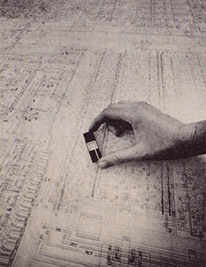
“We went dry for ideas,” says John Pasierb, Midway’s chief electrical engineer. They needed to give the little man, who had evolved into a clown on a unicycle, another weapon to help him deal with the falling balloons. Hank Ross, one of Midway’s founders, got the idea of letting the clown retrieve missed balls by kicking them back into the air. It was decided that on the easy first “rack,” or skill level (some games have as many as 20 racks), the clown would get rid of balloons by popping them with a spike on his hat. But on the second level, the balloons would pile up on his head, so that successive balloons would have a shorter distance to fall from the top of the screen, and the clown would have to pedal faster to get to them. To identify racks as the game progressed, additional falling objects were introduced—flowers, hats and beach balls. While the pedaling clown was catching or kicking these, it was decided there should be occasional hazards too: some of the thrown objects could be anvils that he would have to avoid. Scratch that, said someone; you cannot throw anvils. So eventually, bombs were substituted. (In the violent idiom of video games, this makes perfect sense.)
Hank Ross had another idea that everyone hoped would give the game a last, irresistible quirk of personality. This is known in the business as “the tweak.” He proposed having Baily’s enormously popular Pac Man, a dot-gobbling yellow disc, help the player by eating balloons on the clown’s head. And so it came to pass, and a sneak preview was held at a local arcade. The results, after all of this R. & D., were disastrous. The game, renamed Kick, took too long to play, and thus took in too few quarters. To remedy this, the rate of fall of the balloons was slightly speeded up.
Some time early this year, after further tinkering with the game, Kick will be shipped to distributors and then will appear in the arcades. Baily’s development people think it is fun, but right now, no one has any idea whether it will be a lap jumper or a puddle maker. “This is the most democratic business in the world,” says Mount Prospect, Ill., Arcade Owner Bill Herman. “You got a ballot box, and people vote with their quarters.”
Last year Dun & Bradstreet held a conference for 120 of its managers at Bagatelle Place, a “VIP amusement complex” in the Rye Town, N.Y., Hilton Hotel, which offers a library, a cappuccino bar and 33 video games. This classy arcade enforces a dress code after 6 p.m., and serves banquets at which the changemaking attendants, upon request, dress in dinner jackets.
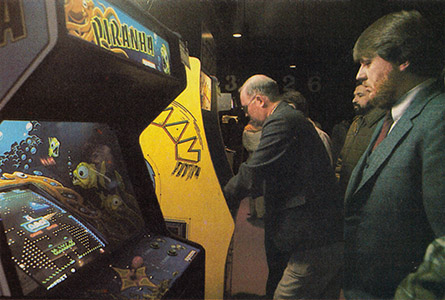
Although Bagatelle staffers deny it, experience suggests that unless these black-tie dinners are stag affairs, they are almost certain to be social disasters. The reasons are that male arcade players tend to outnumber females by about 20 to 1, and that women, especially if they are wives, generally resent the games, and quite often regard them with outright loathing. Ask men and women at random to explain this undeniable phenomenon, and you get chauvinistic patronizing or matronizing of the worst pop-psychological kind. The most temperate analyst is likely to mention that most women are not conditioned as children to be comfortable with complicated gadgets, or to play shooting games. Ear-weary males, their backs welted with wifely sarcasm, may grumble that women are afraid to look foolish in public, or that they simply do not know how to play (a glib reduction comparable to the feminist slur of a few years ago that men do not know how to cry). They say that women view the games as black holes, soaking up male attention, and that even liberated wives are made nervous when their male protectors act like little boys. Women say they are too sensitive to enjoy the bloodthirsty games, and men counter that, no, women are simply too literal-minded to see that the blood is not real and that the games are harmless fantasy. (Though it is hard to deny that some of the fantasies are fairly creepy. As Producer Frank Marshall admits, when you lose your last city—there goes Cleveland—in Missile Command, “it’s depressing.”)
The sunny and cheerful exception to the prevalent theme of electronic Gotterdämmerung, and one of the few games so far that women play in large numbers, is Bally’s Pac Man. Pop psychologizers note that it is not a game of shooting, but—aha!—engulfing. It may also be the ultimate eating disorder; the player directs a happy-looking yellow disc around a maze, as it gobbles cookie-shaped dots, and tries to avoid some not-very-menacing monsters. It is by no means easy to play, though some men feel it is unworthy of serious attention because it has only one hand control. Linda Starkweather, 29, who runs a beauty salon in Union Park, Fla., got hooked on a Pac Man she discovered near by at Jake’s Ice Cream Shop. So did her two women employees. Then they found another Pac Man at a neighborhood sandwich shop arid began straggling back late from lunch hour.
When Starkweather found herself struggling to limit herself at each session to $3 or $4, the obvious next step was to install a Pac Man in her shop. “We’ve spent all our tips already this morning,” she said not long ago, laughing. Ann Williams, one of her former operators and now a Tupperware saleswoman, calls herself a “closet Pacperson.” She admits to spending $15 on one session, and although for a while she didn’t tell her husband, she feels no guilt: “It’s my money; I earned it. There’s not a lot of fun things in life. It’s taken away my boredom. I’ve never been as serious about anything as Pac Man.”
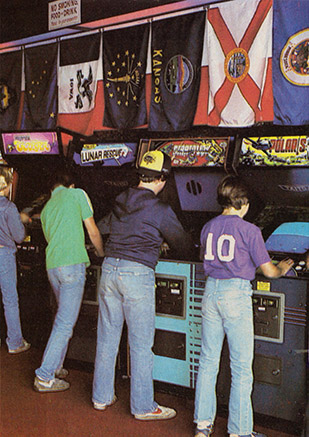
Serious? Listen to Los Angeles Screenwriter Jeffrey Alan Fiskin, who discovered Pac Man earlier this year during the Hollywood writers’ strike: “Oh, pipe down, all you fans of Asteroids and Defenders,” he wrote in California magazine. “Take your arrested adolescence elsewhere! … We want philosophical rigor, a metaphor for life … ” The task of Pac Man, Fiskin notes solemnly, is to clear a labyrinth, and as he succeeds, he collects point-scoring rewards, all very symbolic: first food in the form of fruit, then keys—“the key to wisdom, the key to the next level; ah, the pure Jungian simplicity of it.” Fiskin warns that “you will pay and pay to learn the intricacies of this labyrinth, these demons. The parallel to psychoanalysis has, perhaps, not escaped you … ”
Like many of the best games, Pac Man is a Japanese design, and so far Bally’s Midway division, the U.S. licensee, has produced 96,600 of the machines here (Asteroids is second, at 70,000; and third, at 60,000, is Space Invaders, the game that began the video craze three years ago). Counterfeit machines sell briskly, much to the displeasure of Bally’s lawyers, who are kept busy fighting copyright infringements. Forging a Pac Man or Centipede game is not much more complicated than pirating a music cassette or videotape. A modern game may require six $20 ROM 32-K chips, each of which handles 32,000 bits of information. ROM means “read only memory,” and refers to a permanently programmed chip, not one that can “learn?” and “forget” information. Joel Gilgoff, owner of a four-store arcade games supply chain called G.A.M.E.S., in Van Nuys, Calif., says, “That amount of memory rented for $50,000 a month six years ago.”
The waves of color, shape and sound that crash about the ears of the bedazzled player are really incredibly lavish waves of information. Home TV and such games as Space Invaders use a “raster” TV monitor that forms images made of tiny line segments; Asteroids, Space Fury and other games use an “x-y” monitor that employs unbroken lines. Each line on the TV screen is controlled by an instruction from the machine’s microprocessor. So is each fragment of each sound. The player reacts to the images on the screen and the uproar in his ears, and waggles his controls, which flash impulses to the microchips. The machine depicts the player’s maneuvers instantly, and takes its own countermeasures a microsecond later, all the while keeping score. In due course the dreaded “Game Over” sign flashes, as the chips have ordained.
A desk-top machine called an EPROM programmer (for Erasable Programmable Read Only Memory) can steal the information on a programmed chip and transfer it to a blank chip in about one minute. EPROM units cost about $2,500, which is a great improvement over the $1 million or more it takes to develop a successful new game (see box). Thus it is not hard for a counterfeiter to offer immediate delivery and a price several hundred dollars lower than list.
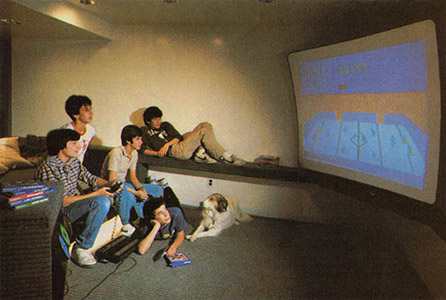
The coin eaters are more challenging, but the home sets back out General Hospital.
Ten minutes ago, let’s say, Pac Man pirates—yo, ho, ho and a chip of rom—did not exist. Now they are only one of the dangers in a fast-shifting market in which hot-shot operators whisper into the ears of kindly and greedy old candy-store proprietors that the right game in a good location can bring in $400 a week, or more than a strong man can earn selling used cars. Put in one and you’ve got a used-car salesman. Take ten and you have a tame orthodontist on a leash. A few store and arcade owners buy their own game machines, counterfeit or not, but most give floor space to machines owned by distributors who farm out and service hundreds of them. Store owners and distributors generally split the take equally. In either case a machine usually must earn back its cost in a few weeks, before local players “learn the board” and are no longer interested. The $400 figure turns out, most often, to be sucker bait, dangled to obscure the dreary truths that markets are becoming saturated and that dud games and obsolete good games bring in no money at all. The fads whirl by so fast that Bally does not even manufacture the historic game Space Invaders any more, although fans buy used machines for sentimental reasons, and many arcades keep one around as a gesture toward the old days.
Wait a minute. Old days? Historic Space Invaders? Just so. There is prehistory, and that is pinball. (And, of course, in Japan there were the jingly pachinko games.) Middle-aged arcade lurkers learned from pinball the cool, bent-kneed stances and the correct ominous angle at which to lip a toothpick. Pinball cost a nickel and had no- K intelligence. It used electromechanical kickers and—talk about primitive!—gravity for power. If you jostled too much it tilted. The very skillful pinball bandit would lift the entire 500-lb. front ends of pinball games off the floor and onto the toes of his Army boots, lessening the incline of the table and foxing gravity. If he won 50 free games, as he was likely to, the blood stopped flowing in his feet. Pinball is still around, although it is not very lively.
Pong, invented by Atari’s founder, Nolan Bushnell, in the early 1970s, signaled the dawn of video-game history. Electronic paddles slapped a ball—really just a white blip—back and forth across a black-and-white TV screen. As Pong evolved, it permitted you to play another person, or, and this was the big excitement, the game would play you. Pong sold enormously for a few months in 1973. And then died. It was pushed into extinction not by a better game, but by its own lack of intelligence; it took a bit of time to master, but after that it was no challenge, and players became bored.
Alien Creatures in the Home
As anyone who has watched the gogglebox over the past six months knows, the television networks sold almighty quantities of advertising time to the makers of home video games. During the pre-Christmas buying frenzy, George Plimpton and that anonymous smug kid argued between halves of everything except the disarmament talks over whether the viewer should spend his last dollar on Atari or Intellivision. The commercial blitz paid off for all of the home console manufacturers. Mattel shipped more than 600,000 Intellivision units, a 300% rise from 1980. And Atari’s Chairman, Raymond E. Kassar, said sales were “a magnitude beyond” earlier figures. Said he: “We all go to bed dreaming we’ll have the kind of Christmas sell-through that we had this year.” This triumph of TV ads-manship seems at first hoot almost suicidal for the networks: for every one of the games that is in play, one television set, to which it must be hooked, is unavailable to receive General Hospital, The Dukes of Hazzard, and much needed information about what kind of snow tire and no-qual beer to choose. Has the tube at last succeeded in strangling itself?
Or do the network ponderosos know something? Are the home video games really not that good?
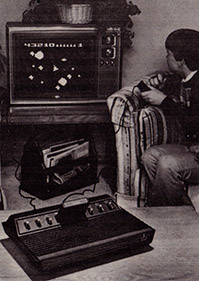
The view here, meticulously opinionated and scrupulously unscientific, is that the home game systems and the cartridges that plug into them range from fairly good to fairly disappointing. None is within a light-year of the best arcade games in color, sound or action. Manufacturers seem to be aware of these shortcomings; add-on voice simulators and cartridges to work them are on the way, and Atari promises a $349 unit that will give its console powerful additional circuitry.
Three firms now dominate the console market. None of them accepts game cartridges made for the other two. Magnavox’s Odyssey 2 costs about $200 for the basic console and $15 to $50 for cartridges. It has good joystick controls, but otherwise is not very satisfactory. The console incorporates a typewriter keyboard, but not much use is made of it in the game cartridges. Graphics seem perfunctory, and the games generally are too shallow to interest adults. Dynasty, a promising maze puzzle based on the Chinese game Go, is too easy to be interesting. Crypto-logic is a not-very-mystifying letter substitution code. Alien Invaders—Plus shows one imaginative quirk, a tiny figure that flees in terror when its fortress is destroyed, but otherwise is an uninspired copy of Space Invaders.
The brightest and most imaginative graphics and sound effects in the industry are Intellivision’s. The most rousing sight in home video is the between-innings sequence of Intellivision’s Baseball, in which, to the sound of cheers, one team trots in to the bench and the other sprints out to the field. The game soon becomes tedious, however, partly because of awkward hand controls (which hamper a good skiing cartridge) and partly because not enough of baseball’s delightful complications are programmed in. It is not possible to catch a fly ball. A Poker and Blackjack cassette is fun to see once, but poor in concept, since neither game works unless money is at stake. Intellivision always puts on a handsome show, but a random sample shows that it has not yet learned to play a really good game.
Atari’s hand controls, too, are poor for a console that costs $150. Cartridges are $18 to $38. But they raise blisters on both adults and teen-agers, and that does not happen unless a game is fascinating. Atari has good simplifications of Space Invaders and Asteroids, and a good Missile Command.
A firm called Acti-Vision makes $23 cartridges that fit Atari’s console, and will soon make them for Intellivision. Acti-Vision’s Laser Blast is a good fast-reflex game in which the player himself is the space invader. Its Tennis has a couple of good illusions-the ball bounces realistically on the court-but no effective simulation of hitting the ball, and no distinction between serves and ground strokes. Like too many cartridges for all three systems, Tennis is likely to be played twice and forgotten.
Nothing much happened in the arcades during the mid-’70s. Those were the Dark Ages: people picked up their pizzas and trudged home. Magnavox had marketed a console programmed so that some 20 games could be played on home television, but the games were not much more challenging than Pong. A line of Mattel hand-held, battery-powered computer games was cleverly engineered, but the games themselves were dull, and the firm almost lost its shirt. Milton Bradley sold a good handheld computer game called Blockbuster, in which the player tried to break down a wall on a tiny video screen. The firm also did well with a simple but clever computer puzzler called Simon; and Texas Instruments made a supposedly educational game called Speak & Spell that used a voice simulator and talked to you. Chess Challenger 7 made a good seven-level chess computer and then complicated it unnecessarily with a voice simulator.
The industry seemed fogbound until 1979. Then, suddenly, airports, delicatessens, gas stations and Chinese restaurants started crawling with electronic columns of squiggly, glowing monsters that marched toward earthmen with a measured thump, thump, thump that changed, as the battle boiled faster, to a frenzied thumpthumpthump. The subtleties that make a game great, or fail to do so, are akin to the mumblings of metaphysics. Space Invaders, a Japanese import licensed to Bally, had an eerie capacity for seizing sane people by the imagination. A minor delight was that the forts behind which the shooter crouched crumbled as they took enemy fire. A major occasion for romantic fatalism occurred as each wave of attackers was expunged and another took its place, so that even the most valiant defender at last was overwhelmed: each teen-ager or corporation blue-suit was his own Beau Geste. But what gave the machine special fascination was its ability to increase the fury of the attack and, as the players improved, the mocking bombast of its splendid sound effects. It was not just a clanking coin-eater. It was, or seemed to be, a sentient alien.
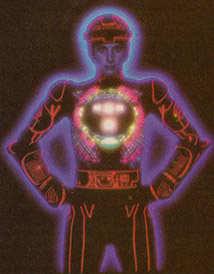
Anyone who played Space Invaders even semiseriously in those days remembers that reports soon spread by jungle telegraph of stupendous scores racked up elsewhere, by “a kid out in Chicago,” “a guy in Jersey.” But by 1980 there was a new big video-game hit, Atari’s Asteroids. This free-moving, doom-in-space melodrama, in which the weightless, drifting shooter tries to blast his way through showers of astral garbage and an occasional scout ship, also had a measure of immortality programmed into it: it was among the first arcade games to invite heroic scorers to record their initials. No game manufacturer has bothered yet to program a system in which local high scores are fed into a national data bank, but there is nothing impossible about the idea, and it might even be profitable, as quarters continue to pour down the coin shoots.
Whither vid-mania? In a Walt Disney film called Tron, to be released this summer, one designer goes berserk and enters the microchip world of video games. Just now, the games are everywhere, and trade publications are full of puff pieces by manufacturers and distributors assuring each other that the game phenomenon is not a fad. They may be right; the Brock Hotel Corp., whose stock registered a 130.2% increase last year, the third highest on the New York Exchange, owes its success to a chain of video-and-pizza parlors. Whatever the future holds, just now the game manufacturers require earth-moving equipment to clear away the coin. In 1981 Baily’s sales jumped to an estimated $880 million from $693 million in 1980. Williams, which makes Defender, saw nine months’ gross sales go from $83 million in 1980 to $126 million last year, and it has just opened a new plant in Gurnee, Ill., capable of producing 600 to 700 Defenders a day.
The other big manufacturer is Atari, whose sales are estimated to have risen more than 120% from 1980 to 1981. Part of this sunny good fortune comes from its heavily promoted consoles and game cartridges for play on home TV. Mattel’s Intellivision and Magnavox’s Odyssey 2 are the primary competitors with Atari for the home market, and the odds are that all three will live or die less on the quality of their engineering than on the cleverness of their games (see box). Until home video consoles evolve as programmable computers (at least two software firms, Broderbund and USE, are marketing programmable games for Apple home computers for less than $50), and until somebody makes a designing breakthrough on the order of Space Invaders to popularize them, it seems probable that the arcade coin-eaters will continue to be the flashiest, noisiest and most villainously intelligent of the video products.
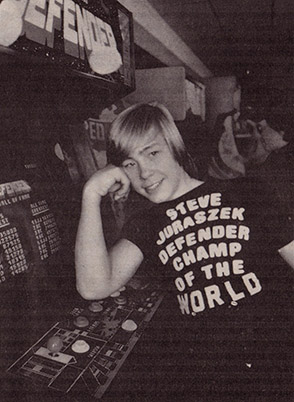
A record? Yeah, 16 hours of wrath and ruination for 25¢.
Talking games are commonplace now; Sega/Gremlin’s Space Fury growls menacingly at prospective players, “So, a creature for my amusement.” As might be expected, new mazes on the order of Pac-Man were common at a recent trade exposition in Chicago. The hit of the show was a highly sophisticated space saga called Eliminator, made by Sega/Gremlin, an imaginative small manufacturer. Up to four players. man the deluxe Eliminator and try to blast each other and the computer until only one player survives for the final combat with the computer. Sega/Gremlin has demonstrated its own three-dimensional game, and a company official says that it should be on the market in twelve to 20 months. Holographic 3-D is a distant possibility, and voice-activated games may come fairly soon. Only high costs block the manufacture of arcade space trainers, in which the player would sit inside a closed, movable cockpit and see nothing but void and space monsters through his windshield. Such a gadget may soon be feasible; computer costs are coming down, and exactions on players are rising to meet them. The 50¢ game is already a gruesome reality in some arcades, and the $1 game is surely speeding toward us by bankrupto-beam through hyperspace.
Mere earthlings, meanwhile, cope as best they can. As might be expected, with-it doctors have detected such video-related maladies as Space Invaders wrist and Pac Man elbow. And of course there are psychological swamps into which enthusiasts may sink. Julie Winecoff, 21, an unemployed truck driver from Charlotte, N.C., paid her way to an Atari tournament in Chicago recently, lost ignominiously to Ok-Soo Han, 25, a Korean immigrant from Los Angeles, and dolefully swore off the stuff. “I’m never going to play another game of Centipede as long as I live,” she said. “I’ve been whupped bad. I’ve been sure ’nuff tore down.”
And Steve Juraszek, hero of song and news story? His high school banned him from leaving the school grounds for a few days because he missed afternoon classes on the day he set his record. But his eye remains on distant peaks. “I’m going to pick a weekend,” he says. “I’ll work out before on those spring things to strengthen my wrists and fingers. Then I’m going to go to sleep right after school on that Thursday and Friday and I’ll start on Saturday morning and go the whole weekend.”
… A man ain’t nothin’ but a
man (plink, plunk)
But before I let that Defender
beat me down,
I’ll die with my blaster in my
hand (plink, plunk)
Die with my blaster in my
hand.
—By John Skow. Reported by Steven Hohnes/ Chicago and Jeff Melvoln/Los Angeles, with other bureaus
Source Pages









